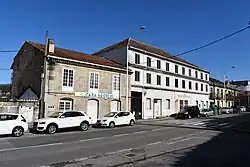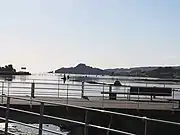Mollavao (Pontevedra)
Mollavao is a neighbourhood in the city of Pontevedra (Spain), in its southwestern area, next to the Ria de Pontevedra. It has mainly a residential function.
Mollavao | |
|---|---|
Neighbourhood of Pontevedra | |
 Rosalía de Castro Street in Mollavao | |
| Coordinates: 42°25′27″N 8°39′14″W | |
| Country | Spain |
| City | Pontevedra |
| Postal code | 36003 |
Location
The Mollavao neighbourhood is located in the southwest of the city of Pontevedra. It is bounded to the northwest by Marín Avenue and the Pontevedra seafront, to the north by Manuel del Palacio Street, to the west by Estrigueiras Street and the AP-9 and to the south by Mollavao Street.
The neighbourhood is divided longitudinally in the centre by Rosalía de Castro Street and its extension towards Marín, the PO-546 road.
History
The ancient sandy cove where Mollavao is located is the origin of the present-day neighbourhood. The name Mollavao comes from molle (wharf) and vao (place of unloading). Mollavao originated as a port area in the Roman Empire, serving as the outport of Pontevedra. The first known mention, as Mollia Vada, is from a document of 1220.[1] In 1595, it was already described in a plan kept in the General Archives of Simancas as a remarkable place in the ria of Pontevedra.[2]
In the first half of the 18th century, the Chapel of the Saints was built in the Baroque style in Mollavao. Its construction was ordered in 1737 by Juan De Marzoa to be dedicated to Saint Francis (whose stone statue was in a niche on the façade) and was completed in 1741. It was a baroque temple of Portuguese inspiration, surrounded by columns crowned with statues of saints (St. James, St. Joseph, St. John, St. Peter, St. Michael, St. Anthony, St. Martin, St. Lupus, the Virgin Mary and the Guardian angel). In the mid-19th century, it was abandoned and its architectural elements and statues were moved to other locations, including the cemeteries of Salcedo and Saint Maurus and the chapel of Saint Blaise.[3][4]
In the mid-19th century, the overall connections between the city and other towns were improved and between 1847 and 1851, Oliva Street and the current Rosalía de Castro Street were built, the extension of which as a road connected the city to Marín through Mollavao.[5]
The Fabril Gallega de Jabones soap factory was set up in the Mollavao neighbourhood in 1938, at the current number 126 Rosalía de Castro Street. The building was designed by the municipal architect Emilio Quiroga Losada and remained in business until 1944, when its owner died. It produced everything from laundry products to bath and toilet soaps. Among the most famous were the San Justo salt soaps.[6][7][8]
In 1944, land was expropriated in the area for the construction of housing for naval officers working at the Naval Military Academy.[9] In Mollavao, on both sides of Rosalía de Castro Street, houses were built for this purpose, surrounded by green areas and gardens.
On 19 May 1947, the project to build a road along the Pontevedra ria between Pontevedra and the Placeres neighbourhood, in the civil parish of Lourizán, was approved. The work on this road, which began in 1949 and was completed in 1955, also modified the Mollavao creek, filling it completely with earth.[10] In 1969, the road was completed with four lanes of traffic and was opened as a four-lane road on 8 August 1969.[11][12]
In 1948 the first tenants started to move into the social housing consisting of small colourful houses around Benito Vicetto Square.[13]
In 1953, the Juan Sebastián Elcano private school (belonging to the Ministry of Defence) was built in the neighbourhood, in Rosalía de Castro Street, next to the Navy's military housing, which began operating in 1954.[14]
On 26 September 1985, the Casa del Mar polyclinic health centre building was inaugurated in the Mollavao neighbourhood, with a total of 89 specialist doctors.[15]
On 21 December 1989, construction began on the AP-9 motorway bridge, the Ria Bridge, and the route of the motorway through the south and west of the city, which crosses the Mollavao neighbourhood on a viaduct and was opened on 25 March 1992. This highway has completely changed the appearance of the area.[16]
In the future, there are plans to build a wide street linking Rosalía de Castro Street to Marín Avenue on the former site of the circus in order to improve mobility in the area.[17][18]
Urban planning
The neighbourhood is a medium to low density residential area with some commercial establishments. It is centred around the central street Rosalía de Castro and the PO-546 road that connects Pontevedra and Marín and passes by the Lourizán Palace, located 2.5 kilometres from the neighbourhood. On its southwestern side, the neighbourhood borders the Pontevedra ria and the Pontevedra seafront, which has a lookout point over the ria.[19]
Mollavao is delimited in the part closest to the city centre, in Rosalía de Castro Street, by the houses built in the mid-20th century for naval officers[20] and by buildings of different heights, and in the area around the PO-546 road by the presence of scattered houses.
The area has a children's playground under the AP-9[21] motorway overpass and a traffic education park.[22] The Fonte Santa playground is also located in Mollavao.[23]
Facilities
Health centres
The main health centre in the neighbourhood is the "Casa del Mar" polyclinic health centre, which is part of the University Hospital Complex of Pontevedra and is a medical centre of reference for many of the inhabitants of Pontevedra.[15]
Schools
Mollavao is home to the Juan Sebastián Elcano private school, which belongs to the Ministry of Defence.[14]
Gallery
_01-18am%252C_cemiterio.jpg.webp) Statue of Saint Martin which was part of the old Saints' Chapel
Statue of Saint Martin which was part of the old Saints' Chapel Road PO-546 through Mollavao
Road PO-546 through Mollavao Viewpoint over the ria de Pontevedra
Viewpoint over the ria de Pontevedra Liceo Mutante in Mollavao
Liceo Mutante in Mollavao Mollavao Square
Mollavao Square Pontevedra seafront, with Mollavao on the right
Pontevedra seafront, with Mollavao on the right Licentiate Molina Street Plaque
Licentiate Molina Street Plaque Villa Corona
Villa Corona Advertising for San Justo soap (1939)
Advertising for San Justo soap (1939)
References
- Sarmiento 1973, p. 279
- "Declaración desta planta de Ponte Bedra en la qual por las letras del A.B.C. se señala todas las cosas notables". Ministerio de Cultura y Deporte (in Spanish). 28 January 2023.
- "Perder la historia... para después olvidarla". Faro (in Spanish). 15 July 2012.
- "Una ciudad de historia y leyendas". La Voz de Galicia (in Spanish). 7 December 2013.
- Durán Villa 2000, p. 90
- "Ugarte, de la fábrica de jabón de Mollavao al balneario de Vilariño". Faro (in Spanish). 3 July 2022.
- "Jabones: pasado (y futuro) de Pontevedra". Faro (in Spanish). 23 August 2015.
- "Talento maragato para promover la industria local". Faro (in Spanish). 23 August 2015.
- "Defensa conserva la propiedad de sus inmuebles sin uso en Mollabao al rechazar el Supremo la reversión". Faro (in Spanish). 18 June 2017.
- "Pontevedra y Marín, unidos por una vía a lo largo de la ría". ABC (in Spanish). 10 August 1955.
- "A Avenida de Marín". Pontevedra Viva (in Galician). 15 March 2018.
- "La autovía a Marín que tardó 20 años en llegar". Faro (in Spanish). 28 August 2016.
- "Benito Vicetto, la plazoleta colorida donde cada vecino cuida un trozo de jardín". La Voz de Galicia. 5 November 2016.
- "En nombre de Juan Sebastián Elcano". Diario de Pontevedra (in Spanish). 9 June 2021.
- "Inauguración de la Casa do Mar de Mollavao". La Voz de Galicia (in Spanish). 26 September 2018.
- "25 años desde que cambió la vista de la ría". Faro (in Spanish). 2 March 2017.
- "Avanzan los trámites del futuro vial entre Rosalía de Castro y la avenida de Marín por Mollavao". La Voz de Galicia (in Spanish). 11 July 2020.
- "Medio Ambiente da luz verde al vial entre Rosalía de Castro y la avenida de Marín". La Voz de Galicia (in Spanish). 10 October 2020.
- "El paseo marítimo queda inaugurado". Diario de Pontevedra (in Spanish). 25 March 2011.
- "La ciudad crece en Campolongo y Mollavao". Diario de Pontevedra (in Spanish). 10 February 2022.
- "Mollavao tendrá un parque urbano en el 2020". La Voz de Galicia (in Spanish). 26 December 2019.
- "Los niños aprenderán seguridad vial con karts en Mollabao". Pontevedra Viva (in Spanish). 23 September 2015.
- "El parque de Mollavao estrena nueva imagen". Diario de Pontevedra (in Spanish). 17 February 2023.
- "'Chao Mollabao', la fiesta que Liceo Mutante organiza para despedirse del barrio". Pontevedra Viva (in Spanish). 16 October 2022.